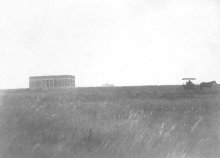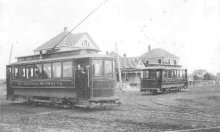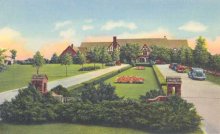Description:
In the early 1890s, an Oklahoma City still in its infancy suffered an economic downturn along with the rest of the country. Many of the less hardy citizens fled the city for greener pastures, but those who stuck it out, clung to hope – and picked up some good land bargains as well. Land speculators were plenty in Oklahoma City in those days and many hoped to make a quick buck buying low and selling high. Many amateurs gambled their money by purchasing land and hoping someone would come along and buy them out. The most successful however, would be those who directed development their way.

The first true genius of development in Oklahoma City was Anton H. Classen. He was born in Illinois, graduated from the University of Michigan with a degree in law, and at the age of 28 took part in the Land Run of 1889 at Guthrie. He moved to Edmond in 1891 and helped secure the Territorial Normal School (now University of Central Oklahoma) and was active in development there. Gauging the winds of change, he moved to Oklahoma City in 1897, just as the city and the country were experiencing a new economic boom. He quickly purchased several hundred acres of farm land beyond the city limits to the north and west. He had become active in the community and eventually was elected president of the Commercial Club (later Chamber of Commerce) and despite the respect many had for him as a businessman, he was often laughed at for holding so much worthless farmland. Classen methodically platted (layed out streets and utility lines and divided up house lots) his land and even went so far as to plant hundreds of trees on the bare plains so they would be mature when houses were built.
The main problem with Classen’s land was that it was too far out. Most developers bought land and built homes which were close enough to downtown for pedestrians. But the city was becoming crowded (between 1897 and 1910 the city boomed in population from 4,000 to 64,000) so lots and homes were kept to small sizes to try and accommodate everyone. But, Oklahoma City had by now developed several extremely wealthy families and they needed estates which could exhibit their success.

In 1902, Classen and his partner John W. Shartel built a street car line which was an immediate success. Where did Classen and Shartel build the line? Well, to Classen’s platted land, of course. Overnight the distance from downtown actually became a selling point. Within a year, Charles Colcord, Henry Overholser and a handful of other city elite built homes in Classen’s Highland Parked Addition which would later become Heritage Hills. Stately Victorian and Colonial mansions sprang up between NW 13th and 16th and Robinson and Walker. The area would eventually extend to NW 21st and would include many styles of architecture before being completed around 1918. Later, Classen would develop several other neighborhoods on land he owned in the near northwest side of the city. He convinced the Methodist church to build Epworth University (now Epworth Methodist Church at NW 18th and Douglas) and developed the land around it.
Classen was not simply a money hungry land speculator, but rather believed that cities could be functional and still be made beautiful and desirable. Such was the trend established by the Chicago School of city planners and landscape architects such as Frederick Law Olmstead. Classen designed wide tree lined boulevards to bring traffic into his neighborhoods. These are still with us today in the major thoroughfare that bears his name and that of his partner, Shartel. He also designed Edmond’s Boulevard before he left in 1897. Classen biographer W. F. Kerr estimates that Classen saw to the planting of about 300,000 trees in Oklahoma City during his lifetime.
By 1907, another national depression occurred and Oklahoma City suffered as well. Classen and others had trouble selling their lots and some neighborhoods, like Heritage Hills, were only partially completed. By 1910, however, a second economic boom came on the heels of the meat packing plants and another railroad line. About this time another great developer came on the scene. G. A. Nichols shared Classen’s vision that cities could grow and yet, remain beautiful. Whereas Classen was a land developer, Nichols was a builder and he combined innovationand efficiency to his construction business.
Raised on a farm near Guthrie, Nichols later trained to be a dentist (he was often called ‘Doc’ Nichols) and set up a practice in Cashion in 1902 and moved to Oklahoma City in 1904. He closed his practice in 1908 and became interested in construction. He realized that by offering a limited number of house plans and by owning his own lumber and building supply business he could dramatically cut costs and still provide attractive, quality homes. Nichols built a home on nearly every remaining lot in Heritage Hills and later developed middle class neighborhoods such as Military Park, Central Park, University Place, Gatewood, and Lincoln Terrace. University Place and Gatewood were Classen developments as well. Nichols continued to be the most prolific builder in the city and was widely respected for his company’s quality and craftsmanship. He continued to develop land throughout the prosperous 1920s and had even tried something new with Nicoma Park – his attempt to provide urban design and amenities in a rural setting.

By 1930, Nichols was ready for his final masterpiece. The Oklahoma City Golf and Country Club was located in what was then rural land at NW 36th and Western. As the city began to crowd the country club, Nichols hatched a scheme whereby he traded land he owned several miles north – north of NW 63rd and Western – for the Country Club’s land off NW 36th. Nichols agreed to build a new $250,000 clubhouse as part of the deal. Of course he also planned to develop his most ambitious project yet – a self-reliant, planned community for the city’s nouveau riche. The project got off to a slow start because of the lasting effects of the Great Depression, but Nichols Hills eventually became the home of some of Oklahoma City’s leading citizens. Incidentally, Nichols’ other project during the Depression years was a great success. He developed a beautiful middle class neighborhood on the grounds of the old Country Club and golf course – Crown Heights.
The post-World War II era brought about yet another housing boom in Oklahoma City. As in cities all over the country, returning soldiers did not wish to return to crowded apartments and row houses or to share living space with their extended family. Affordable automobiles also made distance from the city center a moot issue. Provisions of the G.I. Bill helped make this possible and created a new class of lower and middle class homeowners. Sunbelt cities like Oklahoma City were able to easily make this transition because they had plenty of room and could also learn from the mistakes of the much older cities in the East.
Actually, the first big development came during World War II rather than after it. In one of the shrewdest land speculations ever seen in the city, W. P. “Bill” Atkinson correctly guessed where the Army’s new supply depot was to be located. In 1941, the Army announced it was looking for a place to build a new depot in the center of the country and made public a list of criteria for the base. This was intended to be the largest base ever built by the military and there were only a few places it could be built. Atkinson poured over maps and decided there was only one place which fit the bill – east of Oklahoma City. He quickly and quietly purchased thousands of acres north of SE 29th street and set about platting and designing a self-contained city which would provide homes, entertainment and shopping for Army personnel and for the civilian workforce which would eventually number in the tens of thousands. He called it Midwest City and brought in a leading city planner of the day from Washington, DC to design his city (some of the older parts of Midwest City are marked by diagonal streets like Washington). It was a huge success and eventually this journalist turned developer would see to the establishment of Rose State College and of a daily newspaper. Later, in the 1970s Atkinson developed Quail Springs Mall and the surrounding area despite delays caused by an oil bust. He also developed Oklahoma City’s hi-tech office park just west of Quail Springs. The base? It was named for Osage war hero Clarence Tinker.
Other major postwar developers include George Norman who capitalized on GI Bill and other federal housing programs to build thousands of homes for what he called “the lunch pail crowd” – working class people who were now able to own homes of their own. According to Norman, he started at “[SW] 44th and May and went south” until he ran out of city. He also built hundreds of homes in Del City. A true developer, Norman merely subcontracted the actual construction out various companies. He was thus able to build nearly 300 homes a year. Working into the late 1980s, Norman would also develop homes on the city’s far northwest side.
Ben Wileman was another postwar developer who was active in developing the areas then on the edge of the city limits. He develped the Belle Isle neighborhood, Penn Square Mall and several homes surrounding it, Penn Square Bank, Windsor Hills Shopping Center and Shartel Shopping Center.
On the city’s northeast side Walter J. Edwards, an African-American who became a millionaire through his scrap iron business in the 1930s, entered the development business. Edwards bought a large tract of land east of the area designated by “Jim Crow” laws as the only place blacks could live. In 1941 he built himself a large beautiful home at NE 10th and Grand Blvd. Like other developers in the area he quickly saw the need for more housing for returning soldiers and even though black soldiers received the same GI Bill benefits as other soldiers, they were prevented from using those benfefits because there was no place for them to purchase new single family homes. When Edwards tried to develop the area, he was stonewalled by the local office which handled the distribution of federal funds for housing projects. He and his wife Frances fought this injustice and went all the way to Washington, DC with their case and finally won approval there. As it turns out Edwards may have been the first developer to secure GI Bill and FHA funds for black neighborhoods. In 1946, then, Edwards built about 175 modest single family homes on his property – Edwards Addition. He also paved the way for the Carverdale and Creston Hills developments. The three neighborhoods together make up what is referred to today as the “CEC Triangle.” He also built the Edwards Hospital, the only hospital in the city built and operated by African-Americans and later Edwards School was named in his honor. Edwards never set out to be a civil rights champion – he just wanted to help his neighbors – but he did a great service to ending “Jim Crow” segregation in Oklahoma City and the nation.
Finally, C. B. Warr, who had developed the Cleveland neighborhood just before and during World War II developed Mayfair Heights and Mayfair Shopping Center after the war. Also in the 1940s, Warr built homes in the area between Bethany and Oklahoma City north of NW 39th and developed a “country living” neighborhood with modest homes on acreages. Part of the initial draw was so that residents could maintain “victory gardens” to help ease the food shortage during the war. In 1948, when the area was in danger of being annexed by Bethany, Warr incorporated the area and called it Warr Acres.
FURTHER READING
Alexander, James Edwin. Historical Homes of Lincoln Terrace, Oklahoma City: Southwest Heritage, 1993.
Blackburn, Bob L. Heritage Hills: Preservation of a Historic Neighborhood, [Oklahoma City]: Western Heritage Books, 1990.
Boren, Lyle. Who is Who in Oklahoma, Guthrie, Okla.: Cooperative Publishing, 1935.